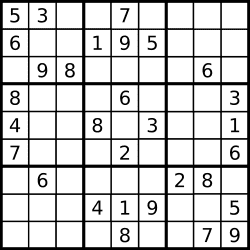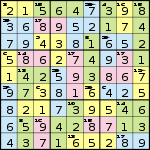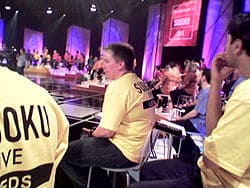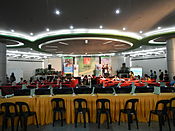

- Chess problem
- Chess puzzle
- Eight queens puzzle
- KenKen
- Mahjong solitaire
- Peg solitaire
- Pentomino
- Prisoners and hats puzzle
- Rubik's Cube
- Tangram
- Three cups problem
- Tiling puzzle
- Tsumego
- Tsumeshogi




 A typical Sudoku puzzle
A typical Sudoku puzzle
 The same puzzle with solution numbers marked in red
The same puzzle with solution numbers marked in redSudoku (数独 sūdoku, digit-single) (, , ; originally called Number Place), is a logic-based, combinatorial number-placement puzzle. The objective is to fill a 9x9 grid with digits so that each column, each row, and each of the nine 3x3 sub-grids that compose the grid (also called "boxes", "blocks", "regions", or "sub-squares") contains all of the digits from 1 to 9. The puzzle setter provides a partially completed grid, which for a well-posed puzzle has a unique solution.
Completed puzzles are always a type of Latin square with an additional constraint on the contents of individual regions. For example, the same single integer may not appear twice in the same row, column or in any of the nine 3x3 subregions of the 9x9 playing board.
French newspapers featured variations of the puzzles in the 19th century, and the puzzle has appeared since 1979 in puzzle books under the name Number Place. However, the modern sudoku only started to become mainstream in 1986 by the Japanese puzzle company Nikoli, under the name Sudoku, meaning single number. It first appeared in a US newspaper and then The Times (UK) in 2004, from the efforts of Wayne Gould, who devised a computer program to rapidly produce distinct puzzles.
 From La France newspaper, July 6, 1895. The puzzle instructions read, "Use the numbers 1 to 9 each nine times to complete the grid in such a way so that the horizontal, vertical, and two main diagonal lines all add up to the same total."
From La France newspaper, July 6, 1895. The puzzle instructions read, "Use the numbers 1 to 9 each nine times to complete the grid in such a way so that the horizontal, vertical, and two main diagonal lines all add up to the same total."Number puzzles appeared in newspapers in the late 19th century, when French puzzle setters began experimenting with removing numbers from magic squares. Le Siècle, a Paris daily, published a partially completed 9x9 magic square with 3x3 sub-squares on November 19, 1892. It was not a Sudoku because it contained double-digit numbers and required arithmetic rather than logic to solve, but it shared key characteristics: each row, column and sub-square added up to the same number.
On July 6, 1895, Le Siècle's rival, La France, refined the puzzle so that it was almost a modern Sudoku. It simplified the 9x9 magic square puzzle so that each row, column and broken diagonals contained only the numbers 1-9, but did not mark the sub-squares. Although they are unmarked, each 3x3 sub-square does indeed comprise the numbers 1-9 and the additional constraint on the broken diagonals leads to only one solution.
These weekly puzzles were a feature of French newspapers such as L'Echo de Paris for about a decade but disappeared about the time of World War I.
The modern Sudoku was most likely designed anonymously by Howard Garns, a 74-year-old retired architect and freelance puzzle constructor from Connersville, Indiana, and first published in 1979 by Dell Magazines as Number Place (the earliest known examples of modern Sudoku). Garns's name was always present on the list of contributors in issues of Dell Pencil Puzzles and Word Games that included Number Place, and was always absent from issues that did not. He died in 1989 before getting a chance to see his creation as a worldwide phenomenon. It is unclear if Garns was familiar with any of the French newspapers listed above.
The puzzle was introduced in Japan by Nikoli in the paper Monthly Nikolist in April 1984 as Sūji wa dokushin ni kagiru (数字は独身に限る), which also can be translated as "the digits must be single" or "the digits are limited to one occurrence." (In Japanese, dokushin means an "unmarried person".) At a later date, the name was abbreviated to Sudoku (数独) by Maki Kaji (鍜治 真起 Kaji Maki), taking only the first kanji of compound words to form a shorter version. Sudoku is a registered trademark in Japan and the puzzle is generally referred to as Number Place (ナンバープレース Nanbāpurēsu) or, more informally, a portmanteau of the two words, Num(ber) Pla(ce) (ナンプレ Nanpuré). In 1986, Nikoli introduced two innovations: the number of givens was restricted to no more than 32, and puzzles became "symmetrical" (meaning the givens were distributed in rotationally symmetric cells). It is now published in mainstream Japanese periodicals, such as the Asahi Shimbun.
The Times of London began featuring Sudoku in late 2004 after a successful appearance in a local US newspaper, from the efforts of Wayne Gould, and rapidly spread to other newspapers as a regular feature. Gould devised a computer program to produce unique puzzles rapidly.
 A nonomino or Jigsaw Sudoku puzzle, as seen in the Sunday Telegraph
A nonomino or Jigsaw Sudoku puzzle, as seen in the Sunday Telegraph
 Solution numbers in red for above puzzle
Solution numbers in red for above puzzleAlthough the 9x9 grid with 3x3 regions is by far the most common, many other variations exist. Sample puzzles can be 4x4 grids with 2x2 regions; 5x5 grids with pentomino regions have been published under the name Logi-5; the World Puzzle Championship has featured a 6x6 grid with 2x3 regions and a 7x7 grid with six heptomino regions and a disjoint region. Larger grids are also possible. The Times offers a 12x12-grid "Dodeka Sudoku" with 12 regions of 4x3 squares. Dell Magazines regularly publishes 16x16 "Number Place Challenger" puzzles (using the numbers 1-16 or the letters A-P). Nikoli offers 25x25 Sudoku the Giant behemoths. A 100x100-grid puzzle dubbed Sudoku-zilla was published in 2010.
Another common variant is to add limits on the placement of numbers beyond the usual row, column, and box requirements. Often the limit takes the form of an extra "dimension"; the most common is to require the numbers in the main diagonals of the grid to also be unique. The aforementioned "Number Place Challenger" puzzles are all of this variant, as are the Sudoku X puzzles in The Daily Mail, which use 6x6 grids.
A variant named "Mini Sudoku" appears in the American newspaper USA Today and elsewhere, which is played on a 6x6 grid with 3x2 regions. The object is the same as that of standard Sudoku, but the puzzle only uses the numbers 1 through 6. A similar form, for younger solvers of puzzles, called "The Junior Sudoku", has appeared in some newspapers, such as some editions of The Daily Mail.
 A Killer Sudoku puzzle
A Killer Sudoku puzzle
 Solution for puzzle to the left
Solution for puzzle to the leftRead main article: Killer sudoku
The Killer Sudoku variant combines elements of Sudoku and Kakuro.
 A Wordoku puzzle
A Wordoku puzzle
 Solution in red for puzzle to the left
Solution in red for puzzle to the leftAlphabetical variations have emerged, sometimes called Wordoku; there is no functional difference in the puzzle unless the letters spell something. Some variants, such as in the TV Guide, include a word reading along a main diagonal, row, or column once solved; determining the word in advance can be viewed as a solving aid. A Wordoku might contain words other than the main word.
"Quadratum latinum" is a Sudoku variation with Latin numbers (I, II, III, IV, ..., IX) proposed by Hebdomada aenigmatum, a monthly magazine of Latin puzzles and crosswords. Like the "Wordoku", the "Quadratum latinum" presents no functional difference with a normal Sudoku but adds the visual difficulty of using Latin numbers.
 Hypersudoku puzzle
Hypersudoku puzzle
 Solution numbers for puzzle to the left
Solution numbers for puzzle to the leftHypersudoku is one of the most popular variants. It is published by newspapers and magazines around the world and is also known as "NRC Sudoku", "Windoku", "Hyper-Sudoku", and "4 Square Sudoku". The layout is identical to a normal Sudoku, but with additional interior squares defined in which the numbers 1 to 9 must appear. The solving algorithm is slightly different from the normal Sudoku puzzles because of the emphasis on the overlapping squares. This overlap gives the player more information to logically reduce the possibilities in the remaining squares. The approach to playing is similar to Sudoku but with possibly more emphasis on scanning the squares and overlap rather than columns and rows.
Puzzles constructed from multiple Sudoku grids are common. Five 9x9 grids that overlap at the corner regions in the shape of a quincunx is known in Japan as Gattai 5 (five merged) Sudoku. In The Times, The Age, and The Sydney Morning Herald this form of puzzle is known as Samurai SuDoku. The Baltimore Sun and the Toronto Star publish a puzzle of this variant (titled High Five) in their Sunday edition. There are often no givens in the overlapping regions. Sequential grids, as opposed to overlapping, are also published, with values in specific locations in grids needing to be transferred to others.
 An example of Greater Than Sudoku
An example of Greater Than SudokuA tabletop version of Sudoku can be played with a standard 81-card Set deck (see Set game). A three-dimensional Sudoku puzzle was published in The Daily Telegraph in May 2005. The Times also publishes a three-dimensional version under the name Tredoku. There is also a Sudoku version of the Rubik's Cube named Sudoku Cube.
There are many other variants. Some are different shapes in the arrangement of overlapping 9x9 grids, such as butterfly, windmill, or flower. Others vary the logic for solving the grid. One of these is "Greater Than Sudoku". In this a 3x3 grid of the Sudoku is given with 12 symbols of Greater Than (>) or Less Than (<) on the common line of the two adjacent numbers. Another variant on the logic of solution is "Clueless Sudoku", in which nine 9x9 Sudoku grids are themselves placed in a 3x3 array. The center cell in each 3x3 grid of all nine puzzles is left blank and form a tenth Sudoku puzzle without any cell completed; hence, "clueless".
Read main article: Mathematics of Sudoku
The results in the following text refer to classic sudoku, disregarding jigsaw, hyper and others.
A completed Sudoku grid is a special type of Latin square with the additional property of no repeated values in any of the 9 blocks of contiguous 3x3 cells. The relationship between the two theories is now completely known, after it was proven that a first-order formula that does not mention blocks (also called boxes or regions) is valid for Sudoku if and only if it is valid for Latin Squares (this property is trivially true for the axioms and it can be extended to any formula).
The number of classic 9x9 Sudoku solution grids is 6,670,903,752,021,072,936,960 (sequence A107739 in OEIS), or approximately 6.67x1021. This is roughly 1.2x10−6 times the number of 9x9 Latin squares. Various other grid sizes have also been enumerated - see the main article for details. The number of essentially different solutions, when symmetries such as rotation, reflection, permutation and relabelling are taken into account, was shown to be just 5,472,730,538 (sequence A109741 in OEIS).
Unlike the number of complete Sudoku grids, the number of minimal 9x9 Sudoku puzzles is not precisely known. (A minimal puzzle is one in which no clue can be deleted without losing uniqueness of the solution.) However, statistical techniques combined with the definition of a new type of generator allow showing that there are approximately (with 0.065% relative error):
The maximum number of givens provided while still not rendering a unique solution is four short of a full grid (77); if two instances of two numbers each are missing from cells that occupy the corners of an orthogonal rectangle, and exactly two of these cells are within one region, there are two ways the numbers can be assigned. Since this applies to Latin squares in general, most variants of Sudoku have the same maximum. The inverse problem - the fewest givens that render a solution unique - was proven to be 17 in January 2012 (confirmed in September 2013). A number of valid puzzles with 17 givens have been found for the standard variation without a symmetry constraint, by Japanese puzzle enthusiasts, and 18 with the givens in rotationally symmetric cells. Over 49,000 examples of Sudoku puzzles with 17 givens resulting in a unique solution are known.
The arrangement of numbers in Sudoku puzzles have greater Shannon entropy than the number arrangements in randomly generated 9x9 matrices. This is because the rules of Sudoku exclude some random arrangements that have an innate symmetry.
The general problem of solving Sudoku puzzles on n2 x n2 boards of n x n blocks is known to be NP-complete.
A popular approach to quickly solve any Sudoku puzzle is programming an application of Dancing Links, with typical results in milliseconds for a 9x9 Sudoku. Although it does not indicate how hard the puzzle would be for humans, at least it is known if the solution is unique, not possible or how many possible solutions exist.
In 1997, Wayne Gould saw a partly completed puzzle in a Japanese bookshop. Over six years he developed a computer program to produce puzzles quickly. Knowing that British newspapers have a long history of publishing crosswords and other puzzles, he promoted Sudoku to The Times in Britain, which launched it on November 12, 2004 (calling it Su Doku). The first letter to The Times regarding Su Doku was published the following day on November 13 from Ian Payn of Brentford, complaining that the puzzle had caused him to miss his stop on the tube.
The rapid rise of Sudoku in Britain from relative obscurity to a front-page feature in national newspapers attracted commentary in the media and parody (such as when The Guardian's G2 section advertised itself as the first newspaper supplement with a Sudoku grid on every page). Recognizing the different psychological appeals of easy and difficult puzzles, The Times introduced both side by side on June 20, 2005. From July 2005, Channel 4 included a daily Sudoku game in their Teletext service. On August 2, the BBC's program guide Radio Times featured a weekly Super Sudoku with a 16x16 grid.
In the United States, the first newspaper to publish a Sudoku puzzle by Wayne Gould was The Conway Daily Sun (New Hampshire), in 2004.
 The world's first live TV Sudoku show, July 1, 2005, Sky One
The world's first live TV Sudoku show, July 1, 2005, Sky OneThe world's first live TV Sudoku show, Sudoku Live, was a puzzle contest first broadcast on July 1, 2005 on Sky One. It was presented by Carol Vorderman. Nine teams of nine players (with one celebrity in each team) representing geographical regions competed to solve a puzzle. Each player had a hand-held device for entering numbers corresponding to answers for four cells. Phil Kollin of Winchelsea, England was the series grand prize winner taking home over £23,000 over a series of games. The audience at home was in a separate interactive competition, which was won by Hannah Withey of Cheshire.
Later in 2005, the BBC launched SUDO-Q, a game show that combines Sudoku with general knowledge. However, it uses only 4x4 and 6x6 puzzles. Four seasons were produced, before the show ended in 2007.
In 2006, a Sudoku website published songwriter Peter Levy's Sudoku tribute song, but quickly had to take down the MP3 file due to heavy traffic. British and Australian radio picked up the song, which is to feature in a British-made Sudoku documentary. The Japanese Embassy also nominated the song for an award, with Levy doing talks with Sony in Japan to release the song as a single.
Sudoku software is very popular on PCs, websites, and mobile phones. It comes with many distributions of Linux. Software has also been released on video game consoles, such as the Nintendo DS, PlayStation Portable, the Game Boy Advance, Xbox Live Arcade, the Nook e-book reader, Kindle Fire tablet, several iPod models, and the iPhone.Also many Nokia phones had Sudoku too. In fact, just two weeks after Apple Inc. debuted the online App Store within its iTunes Store on July 11, 2008, there were already nearly 30 different Sudoku games, created by various software developers, specifically for the iPhone and iPod Touch. One of the most popular video games featuring Sudoku is Brain Age: Train Your Brain in Minutes a Day!. Critically and commercially well-received, it generated particular praise for its Sudoku implementation and sold more than 8 million copies worldwide. Due to its popularity, Nintendo made a second Brain Age game titled Brain Age2, which has over 100 new Sudoku puzzles and other activities.
In June 2008 an Australian drugs-related jury trial costing over A$1 million was aborted when it was discovered that five of the twelve jurors had been playing Sudoku instead of listening to evidence.
 Sudoku competition at SM City Baliuag
Sudoku competition at SM City Baliuag